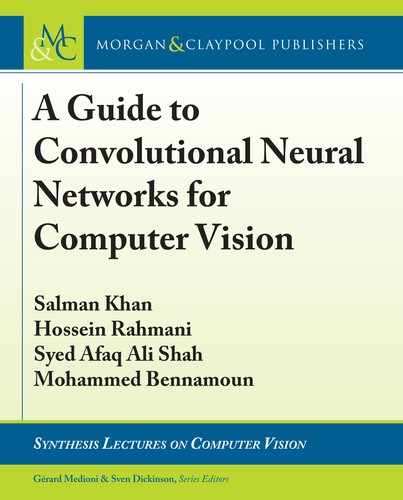The primary goal of this book is to provide a comprehensive treatment to the subject of convolutional neural networks (CNNs) from the perspective of computer vision. In this regard, this book covers basic, intermediate and well as advanced topics relating to both the theoretical and practical aspects.
This book is organized into nine chapters. The first chapter introduces the computer vision and machine learning disciplines and presents their highly relevant application domains. This sets up the platform for the main subject of this book, “Deep Learning”, which is first defined towards the later part of first chapter. The second chapter serves as a background material, which presents popular hand-crafted features and classifiers which have remained popular in computer vision during the last two decades. These include feature descriptors such as Scale-Invariant Feature Transform (SIFT), Histogram of Oriented Gradients (HOG), Speeded-Up Robust Features (SURF), and classifiers such as Support Vector Machines (SVM), and Random Decision Forests (RDF).
Chapter 3 describes neural networks and covers preliminary concepts related to their architecture, basic building blocks, and learning algorithms. Chapter 4 builds on this and serves as a thorough introduction to CNN architecture. It covers its layers, including the basic ones (e.g., sub-sampling, convolution) as well as more advanced ones (e.g., pyramid pooling, spatial transform). Chapter 5 comprehensively presents techniques to learn and regularize CNN parameters. It also provides tools to visualize and understand the learned parameters.
Chapter 6 and onward are more focused on the practical aspects of CNNs. Specifically, Chapter 6 presents state-of-the-art CNN architectures that have demonstrated excellent performances on a number of vision tasks. It also provides a comparative analysis and discusses their relative pros and cons. Chapter 7 goes in further depth regarding applications of CNNs to core vision problems. For each task, it discusses a set of representative works using CNNs and reports their key ingredients for success. Chapter 8 covers popular software libraries for deep learning such as Theano, Tensorflow, Caffe, and Torch. Finally, in Chapter 9, open problems and challenges for deep learning are presented along with a succinct summary of the book.
The purpose of the book is not to provide a literature survey for the applications of CNNs in computer vision. Rather, it succinctly covers key concepts and provides a bird’s eye view of recent state-of-the-art models designed for practical problems in computer vision.
Salman Khan, Hossein Rahmani, Syed Afaq Ali Shah, and Mohammed Bennamoun January 2018
